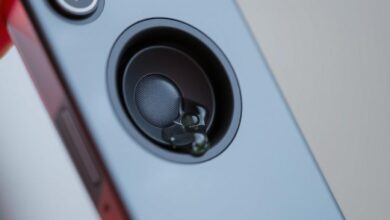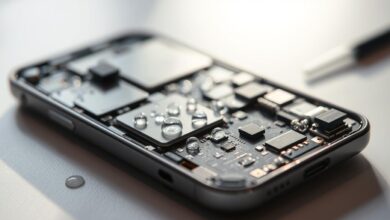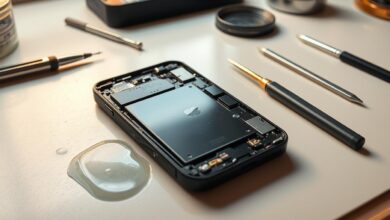how to eject water from iphone
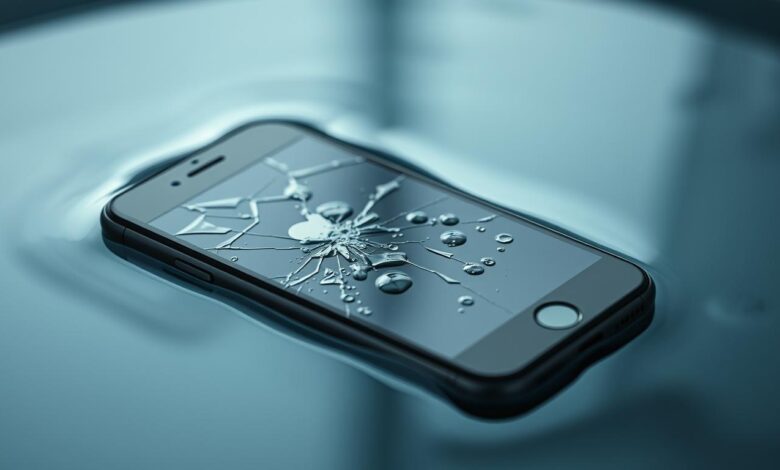
Getting your iPhone wet can be a big worry. If it happened to you, you might be scared about what it could do to your phone. I’m here to help you figure out how to get the water out safely and save your iPhone.
Immediate action is crucial when your iPhone gets wet. The steps I’ll share are to help reduce damage and maybe even save your phone.
Key Takeaways
- Immediate steps to take after water exposure
- Methods to safely eject water from your iPhone
- Tips to prevent further damage
- How to inspect your iPhone for damage
- Precautions to avoid common mistakes
Understanding Water Damage to iPhones
It’s key to know how water damage affects iPhones. Many iPhone users face this issue. It can cause big problems if not fixed quickly.
How Water Affects iPhone Components
Water can get into different parts of an iPhone, harming the inside circuitry. The logic board is especially at risk. When water hits the logic board, it can cause short circuits.
This can make the iPhone not work right or even stop it from working. Water can also rust metal parts, making things worse.
To fix water damage on an iPhone, knowing how water harms its parts is important. The damage can hit not just the logic board but also the battery and screen.
Water Resistance Ratings Explained
iPhones have a IP68 rating for water resistance. This means they can handle dust and water. For example, the iPhone 13 can stay underwater up to 4 meters for 30 minutes.
Even though iPhones are water-resistant, they’re not waterproof. The level of protection varies by model. Knowing your iPhone’s limits helps avoid damage from water.
Immediate Actions When Your iPhone Gets Wet
When your iPhone gets wet, act fast to lessen damage. Quick action can greatly reduce harm to your device.
Power Off Your Device Immediately
Turning off your iPhone quickly is key. It stops short circuits that could harm it more. Press and hold the sleep/wake button until you see “slide to power off.” Then, slide it to the right.
Remove Case and Accessories
Take off any cases, SIM cards, SD cards, or accessories. This lowers damage risk and speeds up drying.
Wipe External Moisture
Use a soft cloth to wipe your iPhone and remove moisture. Be gentle to avoid pushing water inside. This step helps keep water out of your iPhone’s parts.
| Immediate Action | Purpose | Benefit |
|---|---|---|
| Power Off iPhone | Prevent short circuits | Reduces risk of further damage |
| Remove Accessories | Reduce damage to components | Allows faster drying |
| Wipe External Moisture | Remove visible water | Prevents additional water entry |
Different iPhone Models and Their Water Resistance
Different iPhone models have their own water resistance levels. It’s key to know these differences to protect your device and understand its limits if it gets wet.
iPhone 7 Through iPhone 13 Water Resistance
The iPhone 7, from 2016, was the first to offer water resistance. It has an IP67 rating, which means it can handle being underwater up to 1 meter for 30 minutes. Later models, like the iPhone 8, X, XS, 11, 12, and 13, have even better water resistance.
The iPhone 13 Pro, for example, can handle water up to 4 meters deep for 30 minutes. This is thanks to better sealing and design.
| iPhone Model | Water Resistance Rating | Depth/ Duration |
|---|---|---|
| iPhone 7 | IP67 | Up to 1 meter for 30 minutes |
| iPhone 13 Pro | IP68 | Up to 4 meters for 30 minutes |
iPhone 14 and Newer Water Protection Features
The latest iPhones, like the iPhone 14 series, have even better water resistance. They keep the IP68 rating and add new design and engineering features. This makes them more resistant to water.
If your iPhone gets wet, you might need to remove water from the charging port to avoid damage. The newer models are designed to make this easier and lower the risk of water damage.
Using the Water Eject Shortcut on iPhone
Using the Water Eject Shortcut is a great way to save your iPhone from water damage. This feature helps remove water from iPhone speakers and other openings. It might save your device from serious harm.
This shortcut is super helpful if you accidentally drop your iPhone in water. It makes a sound that pushes water out of the speakers.
What is the Water Eject Shortcut?
The Water Eject Shortcut is a tool you can add to your iPhone. It plays a sound that makes water come out of the speakers. You can get it through the Shortcuts app, but it’s not a built-in iPhone feature.
How to Install the Water Eject Shortcut
Installing the Water Eject Shortcut is easy. Make sure your iPhone has the latest iOS first. Then, follow these steps:
- Open the Shortcuts app on your iPhone.
- Tap on the “+” icon to create a new shortcut.
- Search for “Water Eject” in the search bar and select the Water Eject shortcut.
- Tap “Add Shortcut” to add it to your shortcuts list.
After you install it, you can use the Water Eject Shortcut to remove water from your iPhone whenever you need to.
| Step | Description |
|---|---|
| 1 | Open the Shortcuts app |
| 2 | Create a new shortcut |
| 3 | Search for “Water Eject” |
| 4 | Add the Water Eject shortcut |
How to Eject Water from iPhone Using Shortcuts
If your iPhone got wet, a shortcut can help get rid of the water. The Water Eject shortcut is a favorite among iPhone users. It uses sound waves to push water out of the device’s speakers and openings.
Step-by-Step Guide to Run the Water Eject Shortcut
To use the Water Eject shortcut, you need to install it first. Then, follow these steps:
- Open the Shortcuts app on your iPhone.
- Find the Water Eject shortcut and tap on it.
- Confirm you want to run the shortcut.
- The shortcut will play a sound frequency to push water out of your iPhone’s speakers.
It’s important to wait for the shortcut to finish to get the best results.
Troubleshooting Common Shortcut Issues
Even though the Water Eject shortcut works well, some users might face problems. Issues include the shortcut not working right or the sound being too loud.
If you run into these issues, try these fixes:
- Make sure your iPhone is up to date.
- Check that the shortcut is set up right and hasn’t been changed.
- Try adjusting the volume or running the shortcut again a few times.
“Using shortcuts like Water Eject can be a simple yet effective way to mitigate water damage to your iPhone,” says an expert in iPhone repair.
By following these steps and tips, you should be able to get water out of your iPhone using the shortcut.
Alternative Methods to Remove Water from iPhone
If you’re not using the Water Eject Shortcut, there are other ways to dry your iPhone. These methods might save you from a wet iPhone repair. The Water Eject Shortcut is handy, but other methods can also help dry your device.
Using Sound Frequencies
Sound frequencies can help push water out of your iPhone. This method uses specific sounds to get rid of water in your device’s speakers or openings. You can find these sound files online. Playing them at a good volume might help remove water, which could prevent a wet iPhone repair.
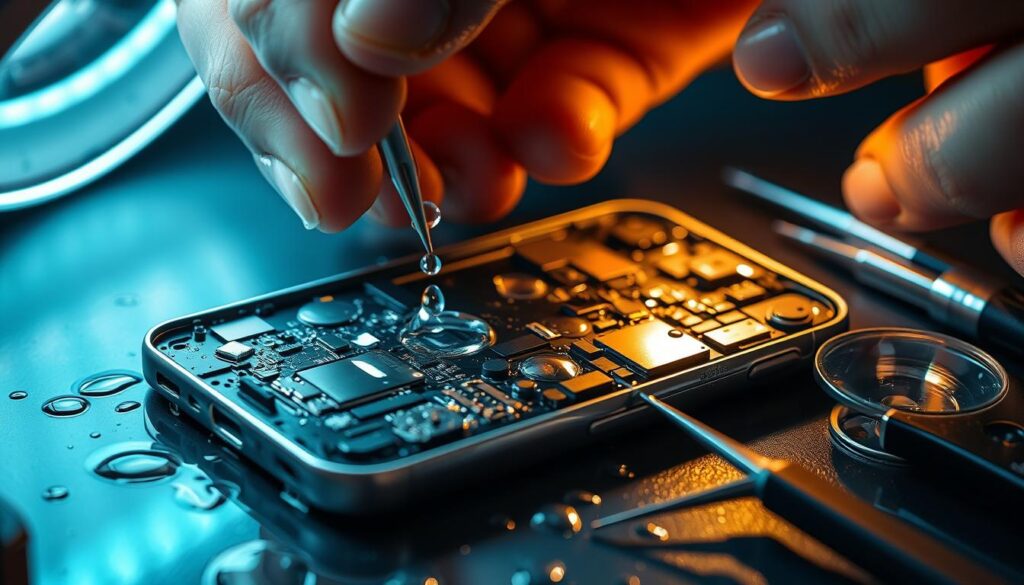
Third-Party Apps for Water Ejection
There are apps that claim to remove water from your iPhone. They use sound frequencies or vibrations. You can find these apps in the App Store. Some apps offer extra features or more ways to remove water. Make sure the app is from a trusted developer to stay safe.
While these apps can be useful, they might not work for everyone. It’s important to have realistic hopes about their ability to avoid wet iPhone repair.
In summary, the Water Eject Shortcut is great, but other methods like sound frequencies and apps can also help. Trying these alternatives might save your iPhone and reduce the chance of needing expensive repairs.
Traditional Methods to Dry a Wet iPhone
If your iPhone gets wet, quick action is key to avoid damage. Over the years, several old methods have been used to dry a wet iPhone. Let’s look at these methods in detail.
The Rice Method: Does It Really Work?
The rice method is a well-known way to dry a wet iPhone. It involves putting your iPhone in a container of uncooked rice to soak up moisture. But, its effectiveness is up for debate. Some people say it works, while others claim it doesn’t help much.
To try it, fill a container with rice, bury your iPhone in it, and wait 24 to 48 hours. But, be careful not to damage your iPhone’s ports with rice dust.
Using Silica Gel Packets
Silica gel packets are another traditional method. They’re found in packaging to control humidity. These packets are great at absorbing moisture and can dry out your iPhone.
Just put your iPhone in a container with several silica gel packets and seal it. Wait 24 to 48 hours for the silica gel to work its magic. This method is better than rice because silica gel is more effective at drying.
Air Drying Techniques
Air drying is a simple way to dry your iPhone. First, gently wipe the outside with a soft cloth to remove moisture. Then, place your iPhone in a dry, well-ventilated area.
You can also use a fan on a low setting to blow air into the ports. But, be careful not to push debris further into your iPhone. Let your iPhone air dry for several days to ensure it’s completely dry. This method is safe and doesn’t risk causing more damage.
By trying these traditional drying methods, you can increase your chances of fixing your iPhone after water damage. While these methods aren’t guaranteed, they’re worth a try before seeking professional help foriphone water damage fix.
What NOT to Do When Your iPhone Has Water Damage
Water damage to your iPhone can be very bad. But, knowing what not to do can help it survive. The actions you take right after can greatly affect its recovery.
Avoid Heat Sources
Many people make the mistake of using heat to dry their iPhone. Avoid using heat because it can harm the inside parts. Let it dry naturally instead.
Don’t Shake or Tap Aggressively
Shaking or tapping your iPhone hard is another mistake. It can damage the inside parts or push water deeper. Be gentle with your iPhone.
Never Charge a Wet iPhone
Charging a wet iPhone is risky. Water and electricity can cause a short circuit. Wait until it’s dry before charging it.
| Action | Consequence |
|---|---|
| Using heat sources to dry iPhone | Potential damage to internal components |
| Shaking or tapping aggressively | Further damage to internal components |
| Charging a wet iPhone | Risk of short circuit |
“The biggest mistake you can make after your iPhone gets wet is not waiting long enough before charging it again. Patience is key.”
By avoiding these mistakes, you can help your iPhone recover from water damage. Remember, gentle handling and patience are key.
Checking for Remaining Water in Your iPhone
After you’ve removed water from your iPhone, it’s important to check if any water is left. This step helps you know if you need to dry your device further.
Visual Inspection Methods
To check your iPhone for water, start by looking at the outside and inside for moisture signs. Look for water droplets on the screen, charging port, or SIM card slot. Also, check the device’s openings for corrosion or mineral deposits.
Use a flashlight to see inside the ports better.
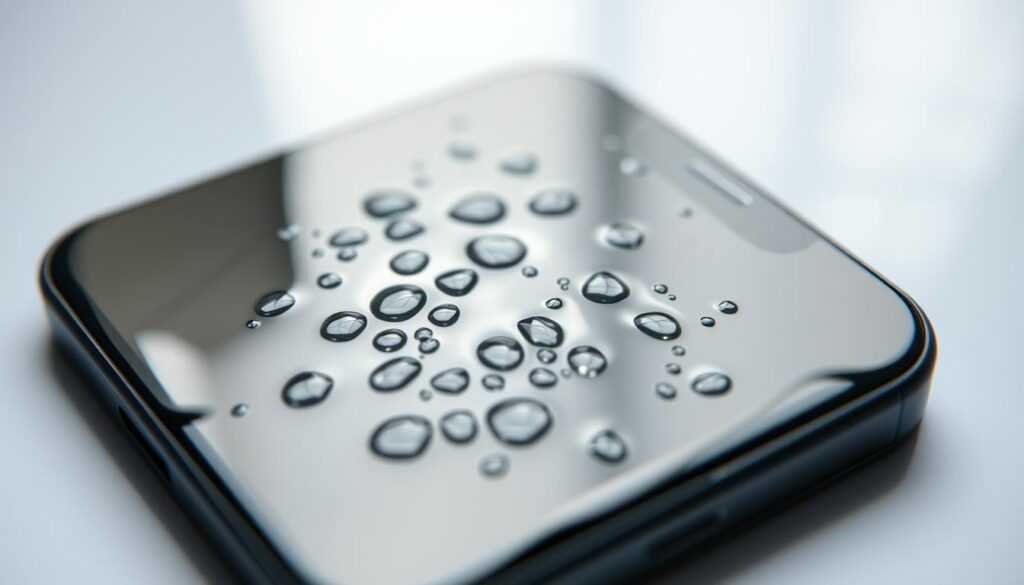
Using the Liquid Contact Indicator
The Liquid Contact Indicator (LCI) in iPhones changes color when it meets water. To check the LCI, look for it in the SIM card tray or charging port. If it’s red or pink, it means water has reached that area.
For more tips on water damage, visit CNET’s guide on handling a wet iPhone.
| Method | Description | Effectiveness |
|---|---|---|
| Visual Inspection | Checking for visible water or corrosion | Moderate |
| Liquid Contact Indicator | Checking for color change in the LCI | High |
By using these methods, you can find out if your iPhone still has water. Then, you can decide what to do next.
Dealing with Water in Specific iPhone Components
When water gets into your iPhone, you need to act fast. It can get into the charging port, speakers, microphone, and buttons. If not fixed right away, it can cause serious damage.
Removing Water from Charging Port
The charging port is very sensitive to water. First, dry the outside with a soft cloth. Then, use compressed air to get rid of any water left. You can also use a desiccant or uncooked rice to soak up the moisture.
Here are some important steps:
- Turn off your iPhone right away to avoid short circuits.
- Don’t use heat like a hair dryer, as it can harm your phone more.
- Use a soft brush or cotton swab to carefully remove any dirt.
Clearing Water from Speakers
Water in the speakers can make sounds muffled or stop them from working. You can use a sound app that makes a special tone to push out the water. Or, try a water ejection shortcut that makes a sound to remove the water.
Addressing Water in Microphone and Buttons
To fix the microphone and buttons, gently tap them against your hand to get rid of water. Dry them with a soft cloth. For better drying, put your iPhone in a dry place or use silica gel packets. Check these areas often to make sure they work right.
To fix water damage iPhone problems with the microphone and buttons, be patient. Let your phone dry completely before you try to use it again.
By following these steps, you can handle water in your iPhone’s parts. This way, you might be able to fix water damage iPhone issues and get your device working well again.
Recovering Data from a Water-Damaged iPhone
Getting data back from a water-damaged iPhone is tough but doable. The first worry is losing your important data. Luckily, there are ways to get your data back, depending on if you backed up your iPhone before.
Using iCloud Backups
If you’ve turned on iCloud backups, getting your data back is easier. iCloud backups save your iPhone’s data, like contacts and photos, in the cloud. To get your data back, erase your iPhone (if it works) or restore it through iTunes or recovery mode. Then, pick to restore from an iCloud backup during setup. This method is simple and doesn’t need a computer.
Make sure your iCloud backup is recent to avoid losing data. Regular backups are key for this method to work. If you’re unsure when your last backup was, check in Settings > [your name] > iCloud > iCloud Backup on another device with the same Apple ID.
Computer Backup Recovery Options
If you’ve used iTunes or Finder backups, you can recover data with a computer. If you’ve synced your iPhone with iTunes or Finder on a computer, you can restore it from that backup. Connect your iPhone to the computer, open iTunes or Finder, and follow the prompts to restore from the backup. This is good if your iCloud backup is old or if you haven’t used iCloud backups.
The success of these methods depends on how much water damage your iPhone has. If the damage is bad, you might need professional help. But, for many, using iCloud or computer backups will get their important data back.
iPhone Water Damage Repair Options
If your iPhone got wet, knowing how to fix it is crucial. There are several ways to repair a water-damaged iPhone. This depends on how bad the damage is and if your warranty is still good.
Apple’s Official Repair Services
Apple has official repair services for water-damaged iPhones. If your device is still under warranty or has AppleCare+, you might get a free or discounted fix. Even if your warranty is up, Apple can still repair your phone for a fee. Apple will check your iPhone to see if it can be fixed.
Key benefits of using Apple’s repair services include:
- Genuine Apple parts
- Expert technicians
- Reliable service
| Service | Description | Cost |
|---|---|---|
| Out-of-Warranty Repair | Apple repairs your iPhone outside of warranty | Varies by model and issue |
| AppleCare+ Repair | Repair with AppleCare+ coverage | Significantly reduced fee |
Third-Party Repair Services
Third-party repair shops also fix water-damaged iPhones. They might be cheaper than Apple, but make sure to pick a good one. This ensures your phone gets fixed right.
When selecting a third-party repair service, consider:
- Reviews and ratings
- Use of genuine or high-quality parts
- Warranty offered on repairs
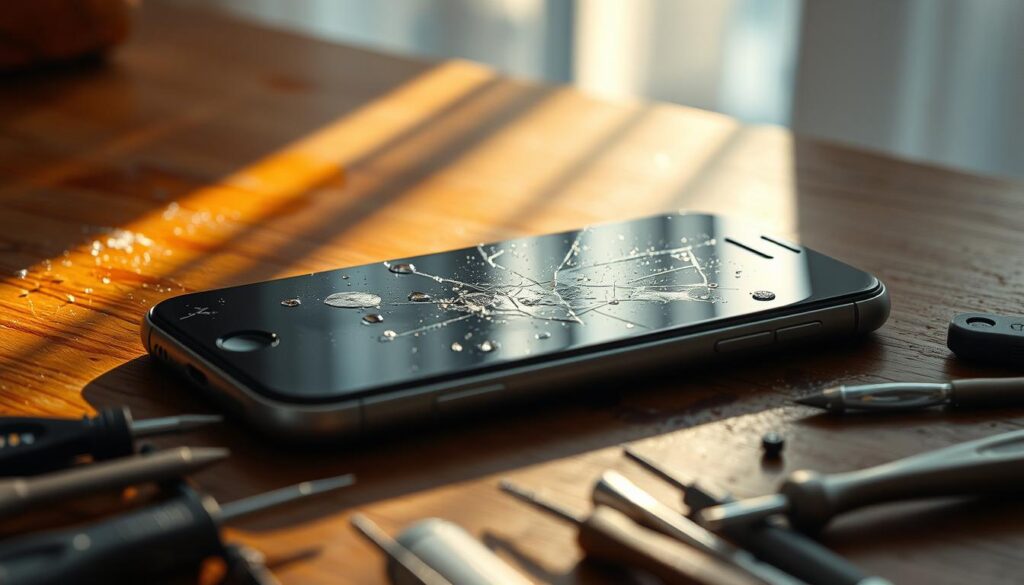
Preventing Future Water Damage to Your iPhone
By taking a few simple steps, you can lower the chance of water damage to your iPhone. Protecting your device is key to keeping it working well and lasting longer.
Waterproof Cases and Accessories
Using waterproof cases and accessories is a great way to prevent water damage. These items create a shield between your iPhone and water, lowering damage risks. Make sure to pick a waterproof case that fits your iPhone model and has strong water resistance.
Key Features to Consider:
- IP68 rating or higher
- Sealed ports and buttons
- Durable materials
| Brand | Model | Water Resistance Rating |
|---|---|---|
| LifeProof | FRĒ SERIES | IP68 |
| Catalyst | Waterproof Case | IP68 |
| OtterBox | Defender Series | IP68 |
Situations to Avoid with Your iPhone
Protecting your iPhone is not just about using gear. Being careful about where you use your iPhone also helps. Stay away from using it near water or in damp places.
Situations to Avoid:
- Using your iPhone in the shower or bathtub
- Exposing your iPhone to heavy rain or snow
- Leaving your iPhone in a humid environment for extended periods
When to Seek Professional Help
Even with your best efforts, some iPhone water damage might need a pro. DIY fixes work for small problems, but serious issues need an expert. This ensures your device is fixed right and avoids more harm.
Scenarios That Require Expert Assistance
There are times when you should get help from a pro. These include:
- Significant water exposure: If your iPhone was underwater for a long time or got a lot of water.
- Persistent issues: If DIY fixes didn’t work and your iPhone still has problems, like bad sound or charging issues.
- Internal component damage: If you think water got to the inside parts, getting a pro to check is key.
Finding Reliable iPhone Repair Services
Finding a good repair service is crucial. Here’s how to do it:
| Criteria | Apple Authorized Service | Third-Party Repair Shops |
|---|---|---|
| Cost | Generally more expensive | Often less expensive |
| Warranty | Typically comes with a warranty | Varies by shop |
| Quality of Parts | Uses genuine Apple parts | May use third-party parts |
Knowing when to get help and finding a good repair service helps fix your iPhone right. It also reduces the chance of more damage.
Conclusion
Dealing with a wet iPhone can be stressful. But, knowing the right steps can make a big difference. By learning how to get water out and taking precautions, you can reduce damage risks.
Whether you use the water eject shortcut or look into repair options, acting fast is key. If your iPhone gets wet, quickly check the damage and dry it out. For serious water damage, getting professional help might be best.
Being proactive and informed helps protect your iPhone from water damage. This way, your device can last longer. If you need help with wet iPhone repair or have water resistance concerns, talk to a professional for advice.
FAQ
How do I eject water from my iPhone?
To get water out of your iPhone, use the Water Eject Shortcut. It makes a sound that pushes water out. You can also try sound frequencies or apps made for this purpose.
What should I do immediately when my iPhone gets wet?
First, turn off your iPhone. Then, take off any cases or accessories. Gently wipe off any water you see. Don’t charge it or use heat to dry it.
Can I charge my iPhone after it’s been exposed to water?
No, don’t charge a wet iPhone. Wait until it’s completely dry before you try to charge it.
How can I check if there’s still water inside my iPhone?
Look for water signs like moisture in the charging port or speakers. You can also use a Liquid Contact Indicator.
What are some common mistakes to avoid when dealing with water damage on my iPhone?
Don’t use heat, shake, or tap your iPhone. These actions can make damage worse. Also, don’t charge a wet iPhone.
How can I recover data from a water-damaged iPhone?
Try to recover data from iCloud or computer backups. If that doesn’t work, get help from Apple or a repair service.
What are my options for repairing a water-damaged iPhone?
You can go to Apple or a third-party repair service. Make sure to compare prices and read reviews before choosing.
How can I prevent future water damage to my iPhone?
Use waterproof cases and avoid water. Be careful in wet places like near pools or in the rain.
When should I seek professional help for my water-damaged iPhone?
If you’re not sure how to fix it or if the damage is bad, get help from Apple or a repair service.
Can I fix water damage on my iPhone myself?
You can try to get water out using different methods. But, serious damage might need a pro. Be careful not to make it worse.
How do I dry out my iPhone after water damage?
Use silica gel packets or air drying. Avoid heat or shaking your iPhone too much.
